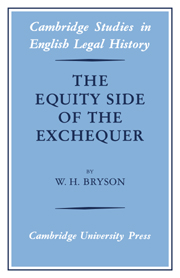Book contents
- Frontmatter
- Contents
- Preface
- Principal abbreviations
- Table of statutes cited
- 1 Introduction
- 2 The equity jurisdiction of the exchequer
- 3 The administration of the court
- 4 Procedures and records
- 5 The suppression of the jurisdiction
- Appendix 1 Chart showing the quantity of bills filed
- Appendix 2 Lists of officers
- Bibliography
- Index
- Frontmatter
- Contents
- Preface
- Principal abbreviations
- Table of statutes cited
- 1 Introduction
- 2 The equity jurisdiction of the exchequer
- 3 The administration of the court
- 4 Procedures and records
- 5 The suppression of the jurisdiction
- Appendix 1 Chart showing the quantity of bills filed
- Appendix 2 Lists of officers
- Bibliography
- Index
Summary
The equity side of the court of exchequer ‘is by far the most obscure of all the English jurisdictions’, declared the learned Plucknett. The purpose of this essay is to shed some light upon this court and to explore its jurisdiction, to introduce its staff, to discover its procedures, to explain its equity records, and perhaps to render Plucknett's statement obsolete.
Substantive law is inextricably intermingled with the procedures of the court; the practicalities of the prosecution of a lawsuit can never be neglected. Of initial and fundamental importance is that for which the petitioner prays. In practical terms this was a remedy for a grievance or a complaint; in larger terms and in the context of this study, this was the prayer for equitable relief. This study demonstrates that equity was bigger than the chancery and that others besides the lord high chancellor had a hand in its development. It is true that the court of chancery was the most important court of equity, but the existence of an alternative high court of equity in the exchequer had a significant effect upon the development of equity and upon the chancery itself.
The historian must by his nature be involved with institutions since human beings exist within their institutions. He must know why these institutions were erected, how they affected their people, how they evolved, why they perished. Moreover, among the major sources of historical evidence for the writer on the sixteenth century and earlier are the records of the courts of law.
- Type
- Chapter
- Information
- The Equity Side of the Exchequer , pp. 1 - 8Publisher: Cambridge University PressPrint publication year: 1975



